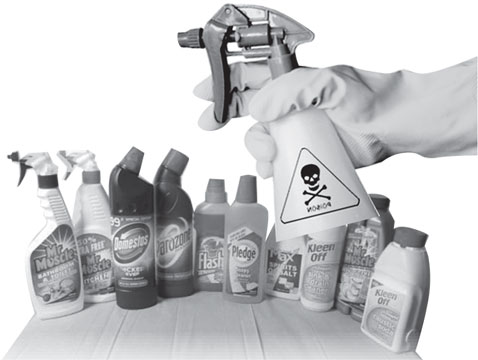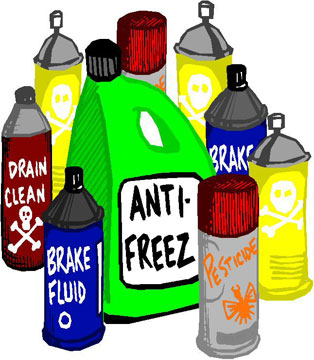Is your family at risk of household poisoning?
Toxic exposures to cleaning agents are increasingly
the cause of hospital admissions :
by Carol Aloysius
 Those detergents to keep your dishes and sink sparkling, and even the
fragrance you use may seem reasonably safe according to the labels. Yet,
hidden inside them are toxic chemicals that can cause acute or long term
health impacts, warn health experts, who say, exposure to such toxic
chemicals are increasingly sending people to hospital. Those detergents to keep your dishes and sink sparkling, and even the
fragrance you use may seem reasonably safe according to the labels. Yet,
hidden inside them are toxic chemicals that can cause acute or long term
health impacts, warn health experts, who say, exposure to such toxic
chemicals are increasingly sending people to hospital.
Take a look at some recent findings from US Poison Centres:
In 2000, cleaning products were responsible for as many as ten
percent of all toxic exposures reported to the US Poison Control Centres.,
accounting for 206,636 calls. Of these, 120,434 exposures involved
children under six, who swallowed spilled cleaners left open and within
their reach inside the home.
In poison statistics cited in the National Data 2014 in the US ,
fifty five Poison Centres provided telephone guidance for nearly 2.2
million human poison exposures. That accounted for 6.7 poison exposures
per 1,000 population and 42.6 poison exposures in children younger than
six years per 1,000 children.
The US Poison Centres also noted that one poison exposure was
reported to their call centres every fifteen seconds!
While young children (younger than 6 years) comprise a
disproportionate percentage of the cases, poisoning affects ALL age
groups, from infants to seniors. Peak poisoning frequency occurs in one
and two year olds, but poisonings in teens and adults are more serious.
Notice that the greater proportion of males in poison exposures
occurring in children younger than 13 switches to a female predominance
in teens and adults, the report said.
|

Dr Waruna Gunethileke |
In Sri Lanka, the scenario is just as scary due to most families now
using detergents for cleaning households, and more men and women are
able to afford cleansing creams, aftershave lotions and perfumes for a
better grooming. Few or none realize that they contain toxic substances
which could lead to dangerous health impacts on the user and the family
as a whole. After all , as long as they can do what they claim i.e.
clean, why bother to look beyond?
The Sunday Observer spoke to the Head of the National Poisons
Information Centre, Dr Waruna Gunethileke for some insights into these
hidden dangers.
Excerpts...
Is household poisoning from cleaning detergents , fragrances, and
other household items on the increase? Why?
A. Compared to a couple of decades ago, the answer is Yes. To
cite some figures on emergency calls received at our call centre last
year ( 2015) of household poisoning , we had 283 such cases. We also had
228 calls regarding swallowing of medicinal drugs ( either the wrong
drugs or an overdose.) The latter is now a growing problem in the
country as most drugs given in government hospitals are a month supply .
This is a huge amount of tablets which to make matters worse is
packed in small envelopes which can be torn easily . So it is important
they are kept away from small children especially those between the ages
of 2-4 years.
Is it a new trend?
A To answer that let's go back to the time of our ancestors.
They simply used used lime ( dehi) and ash ( alu,) later graduating to
soap and water to clean their dishes, pots and pans. Today, most modern
households have dish washers, ovens that need to be cleaned regularly,
and cleaning agents that can do this work efficiently and quickly
because time is an important consideration. So, those who can or even
cannot afford them, allocate a part of their budget for purchasing the
latest detergent in the market based on their claims.
How toxic are these cleaning agents?
A. It varies from the type of detergent used. But, they all
have toxic substances. Take bleach and disinfectant for example. They
contain ingredients with high acute toxicity. These include chlorine
bleach, ammonia and acids. In addition there are petroleum products like
keresone oil and diesal, which have extremely dangerous health impacts.
Can these chemicals or detergents degrade over time?
A. Yes, with long lasting effects as it affects the
environment.
What are the adverse health impacts ?
 A. Long term effects vary with the type of health hazard .
Some cause acute or immediate hazards such as skin or respiratory
irritation, watery eyes, or even chemical burns. Others are associated
with chronic or long term effects, like cancer. A. Long term effects vary with the type of health hazard .
Some cause acute or immediate hazards such as skin or respiratory
irritation, watery eyes, or even chemical burns. Others are associated
with chronic or long term effects, like cancer.
Corrosive chemicals can cause severe burns to eyes and skin on touch,
and if ingested, affect the throat and oesophogas, as well. Ingredients
with high toxicity include chloride bleach and ammonia which produce
fumes highly irritant to eyes, nose , throat and lungs .
Who is most at risk from these toxic household chemicals?
A. Asthma patients, heart and lung patients, and any person
with compromised respiratory problems.
What about persons with allergies?
A. Persons with allergies are also vulnerable to, especially,
fragrances that are added to many cleaners, notably, laundry detergents
and fabric softeners may cause respiratory irritation, headaches and
watery eyes to sensitive persons.
Due to the dengue menace there is an increasing use of mosquito coils
and sprays. Have there been increasing reports and calls to your office
with regard to adverse health impacts?
A. I am glad you mention this, as we have had several calls
where people have complained of breathing difficulties and various
allergies and skin irritation from exposure to mosquito coils and more
recently to mosquito sprays.
What is the reason?
A. It is probably because many people who can't afford to buy
mosquito sprays are now purchasing them at discounted prices in the
Pettah .
Our advice is to use them safely. Remember they contain toxic
chemicals are are harmful for your health.
What about rigifoam boxes which children and adults pack their snacks
or even meals in?
A. We have scientific evidence to prove that they carry very
dangerous health hazards as they too contain chemicals that leach into
the food.
These petroleum based products contain polystyrene, which contain two
chemicals, Styrene and Benzene. These chemicals interact with warm food,
drinks (all types - fruit and fizzy drinks included), and acid food like
pineapple, pickle and lime and have adverse effects on one's health.
How?
A. When Polystyrene comes into contact with any of the foods
mentioned, it leaches the two toxic chemicals, which are fat soluble,
into the food. They can easily leach into the butter used in a sandwich
or oil used to fry a roll.Always try to avoid using these boxes for your
food . If you must buy them , purchase only those that are of food grade
quality. That applies to lunch sheets as well.
What are the health impacts of using rigifoam boxes to pack your
lunch?
A. As I said these petroleum based products contain polystrene
which contains Styrene and Benzene. Styrene is carcinogenic (cancer
causing) and has a neurotoxin (affecting the nerves) effect. It
dissolves the fat tissues and causes chromosome damage. Benzene is also
carcinogenic. However, its toxic effects depend on the level of exposure
to it.
The important thing to remember is all plastics and polythene are
petroleum based products, which contain these two deadly toxins. The
impact they have on one's health in the short term or long term, will as
I mentioned earlier, depend on the level of exposure and the duration of
such exposure.
Your advice regarding household poisoning in general?
A. Reduce detergents use for cleaning, as well as other
substances containing chemicals that can trigger allergies and cause
health risks to people in the house. And, never leave open detergents
within reach of children .
Also, make sure that cupboards containing poisons such as, pesticide
and insecticides are locked, and your tablets are kept inside pill boxes
away from the reach of children.
Household injuries have become very common and are among the leading
cause for admission to hospital, especially children. Swallowing seeds
from rambuttans and large gauvas and even mango and mangosteen seeds are
very common. So, watch your child when he or she eats these fruits.
Don't let them put them up into their nose or choke on them.
Watch your child at play in the house as well, and remove chairs that
have broken legs which could be used to climb or sit on. Make your
bathrooms safe. Put disposable razers and used creams in plastic bags
and dispose of them carefully.
Mothers should keep their sewing boxes away from children as needles
and even thimbles can find their way into small noses. Moth ball
poisoning is also common in children between two to 14 years today.
Follow these golden rules and ensure your family has a safe school
vacation. |

